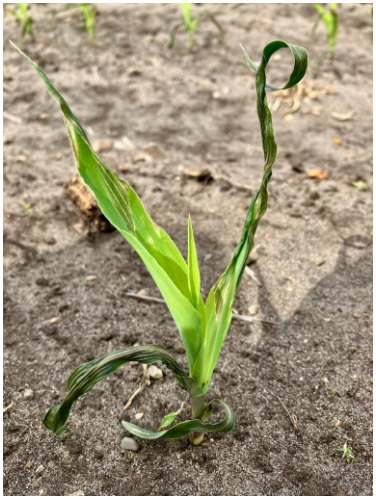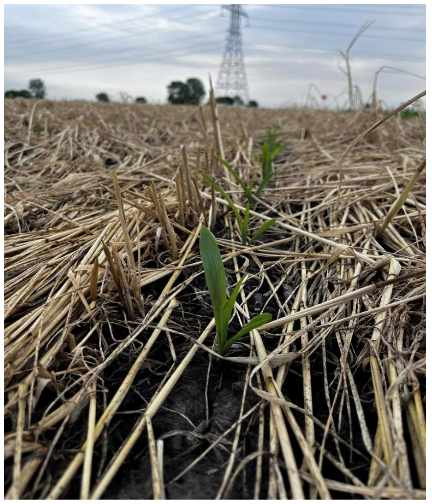Planting wrapped up last week at the Pinney Purdue Agricultural Center (PPAC) in Wanatah, IN, and the week before at the Agronomic Center for Research and Education (ACRE) in West Lafayette, so our two main Purdue Corn Team research sites are in the ground and growing. Research trial planting is still ongoing and delayed at our Northeast, Eastern, and Southeastern Indiana research locations due to continued rainfall and wet conditions.
During the week of May 16th, a significant wind and dust storm impacted many corn and soybean fields primarily in West Central portions of the state (e.g., White, Pulaski, Benton counties). Following the impacts of this storm, many corn plants in these areas were exhibiting the effects of excessive wind and foliar damage caused by blowing soil particles or “sandblasting” (Figures 1 and 2). Foliar damage severity was more pronounced in conventionally-tilled fields with minimal to no surface residues which can act as a “shield” from soil particle movement. Overall, fields which were no-tilled or had cover crops were noticeably less impacted by the dust storm.

Figure 2. Young corn plant impacted by wind and sandblasting damage due to high winds in Pulaski County, IN. (Photo Credit: Phil Woolery, Purdue Extension)
Despite the observed foliar damage, the fortunate part is that young corn plants (e.g., V5 growth stage or younger) can withstand high levels of above-ground leaf tissue damage. Overall, when conditions like these occur, it is important to be patient and to examine plants after a few days to assess plant recovery. For example, many of the recently impacted corn fields in these areas have exhibited healthy, new leaf growth (Figure 2) a few days after the wind storm and no measurable yield loss impacts or replants are expected. In addition, “bending” corn plants due to the high winds and wet soil conditions in certain areas of the state (Figure 1) will recover and correct themselves as conditions improve and the plants continue to develop. Currently, our team has not been informed of any replanted corn occurring in these areas, but many soybean acres had to be replanted.
Ongoing Cover Crop Research
Since 2022, the Purdue Corn Team has continued research trials which examine the management of corn following a cereal rye cover crop (Figure 3). Cereal rye is widely regarded as an excellent cover crop for Midwest cropping systems. It establishes well and produces substantial above- and below-ground biomass across diverse locations, planting timelines, and environmental conditions. In Indiana, cereal rye is often the primary cover crop option for many corn and soybean farmers due to the timing of fall cash crop harvests and prevailing environmental factors. Its robust growth and biomass production effectively support cover crop goals, such as reducing excess soil nitrate in the fall and spring, suppressing weeds, influencing soil moisture, minimizing soil erosion, and contributing organic matter to the soil.
However, despite these benefits, managing cereal rye in the spring can be challenging, particularly for farmers planting corn as the subsequent cash crop. Yield reductions in corn following rye are commonly attributed to equipment interference, causing poor seed placement, seed-to-soil contact, and emergence, and reduced nitrogen and sulfur availability and nitrogen and sulfur immobilization, caused by the high carbon-to-nitrogen ratio of rye biomass.
Recent Purdue research highlights key strategies to manage corn planted after cereal rye and many of these trials continue and are being expanded upon. Trials conducted in West Lafayette, IN, in 2024 revealed sulfur deficiencies in corn following cereal rye, which were corrected with a sidedress application of 15 lbs/acre sulfur (as ammonium thiosulfate), resulting in a 15 bu/acre yield increase. In contrast, sulfur had no effect where rye was not used as a cover crop. Additional studies at Lafayette, IN and Butlerville, IN research locations in 2022 and 2023 tested planter closing wheel options and found that cast-iron, spiked closing wheels in comparison to standard round, rubber closing wheels resulted in improved corn emergence and yield in high-residue rye systems by enhancing furrow closure and seed-to-soil contact. These results underscore the importance of proper planter settings, planter equipment, and early-season nutrient management when growing corn after cereal rye. Overall, our current best practices include applying 40–60 lbs/acre of nitrogen in a 2×2 starter band at planting, supplementing with sulfur if needed (via preplant, starter and/or sidedress applications), and splitting nitrogen applications with an in-season sidedress application at V4–V6 to align with rye decomposition and limit nitrogen immobilization. Terminating rye 2–3 weeks before planting and closely monitoring planting conditions can also help to reduce further risks. Overall, the most important item we have found is that corn management must differ and must be more precise in many cases when following cereal rye vs. when it does not follow cereal rye.




